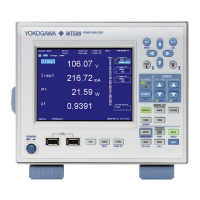2-19
IM 760201-01E
Features
3
2
1
4
5
6
7
8
9
10
11
12
13
14
App
Index
2.5 Computation
The following computations can be performed with the data of measurement functions. In
addition, there is a function that allows you to select the equation used to determine the
measurement function data.
Setting the Equation for Computing Efficiency (See section 5.3 for operating
instructions)
To measure the input/output efficiency of a device, set the equations for
η
1 and
η
2.
For example, if the input power to a device is P1 and the output power is P
Σ
, you can
compute the power conversion efficiency of the device by setting the equation to
η
=
(P
Σ)
/(P1) × 100.
Setting the Equation for Computing Apparent Power (See section 5.4 for
operating instructions)
Apparent power is the product of voltage times current. The voltage and current used to
determine the apparent power can be selected from (1) the true rms values explained
under “Determining Voltage and Current” in section 2.2, “Measurement Functions
and Periods”; (2) the rectified mean values calibrated to the rms values; (3) the linear
averages; (4) the rectified mean value calibrated to the rms value of the voltage and the
rms value of the current; and (5) the rms values.
Selecting the Computing Equation for Apparent Power and Reactive Power (See
section 5.4 for operating instructions)
There are three types of power: active power, reactive power, and apparent power.
In general, they are defined by the following equations.
Active power P = UIcos
f
..............................................................(1)
Reactive power Q = UIsin
f
..........................................................(2)
Apparent power S = UI .................................................................(3)
U = rms voltage; I = rms current;
f
= Phase difference between voltage and current
The power values are related as follows:
(Apparent power S)
2
= (Active power P)
2
+ (Reactive power)
2
.... (4)
The three-phase power is the sum of the power of each phase.
These definitions only apply for sine waves. The measured values for apparent power
and reactive power vary for distorted waveform measurement depending on which of the
above definitions are combined for the computation. Because the equations for deriving
the power for distorted waveforms are not defined, none of the equations can be said
to be more correct than the other. Therefore, the WT500 provides three equations for
determining the apparent power and reactive power.
Unlike apparent power and reactive power, active power is derived directly from the
sampled data, so errors resulting from different definitions do not occur.
Type 1 (The method used in the normal mode of conventional WT series
power meters)
The apparent power of each phase is calculated using equation 3, and the reactive
power of each phase is calculated using equation 2. The results are summed to derive
the power.
Active power for a three-phase, four-wire system
P
Σ
= P1 + P2 + P3
Apparent power for a three-phase, four-wire system S
Σ
= S1 + S2 + S3( = U1×I1 +
U2 × I2 + U3 × I3)
Reactive power for a three-phase, four-wire system
Q
Σ
= Q1 + Q2 + Q3
(= s1×
(U1 × I1)
2
– P1
2
+ s2 × (U2 × I2)
2
– P2
2
+ s3 × (U3 × I3)
2
– P3
2
)
The sign for s1, s2, and s3 is positive when the current leads the voltage and negative
when the current lags the voltage.

